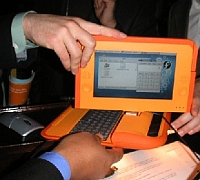OLPC is claiming they've achieved the impossible under the direction of Mary Lou Jepsen:
Our display has higher resolution than 95% of the laptop displays on the market today; approximately 1/7th the power consumption; 1/3rd the price; sunlight readability; and room-light readability with the backlight off.Or at least as a dual-mode prototype that theoretically can be produced in standard LCD factories, without major changes.
If able to achieve production level scale, this is BIG NEWS and will revolutionize laptops worldwide.
We'll have laptops that last 21 hours instead of 3 hours and prices will drop by 1/2 as displays are the most expensive part of a laptop today.
That might not be OLPC's main aim but it would be its most technology shifting achievement.



i've heard rumors that apple's next video ipod will have a monochrome
display mode that is viewable in sunlight -- giving it an ebook-like capability.
If you want to see the dual-mode display prototype, it will be at OLPC in Cambridge on August 17th. Mary Lou Jepsen is flying with it from San Diego for a home office demo.
Just to be clear (no pun intended)--
Each pixel can be black-and-white or a color-- that is, one predefined color, not just any color. This is done through a clever trick of polarization and filtering that makes the color subpixels work as monochrome pixels in reflective mode. When backlit, they produce color whether you want it or not.
The true color resolution is not more than 600 x 450 (that is, less than VGA resolution). The apparent/effective resolution may be somewhat higher, but this gets complicated.
The human eye has higher native luminance (brightness) resolution than chrominance (color) resolution. This characteristic is leveraged to great advantage in everyday consumer products.
DVDs, for example, have a luminance resolution of 720 x 480 pixels, but a chrominance resolution of just 360 x 240. Similarly, a 4-megapixel digital camera gets brightness information at 4 million sensor sites, but it only gathers "blueness" or "redness" information across groups of 4 sites-- so its color resolution is just one megapixel in this sense.
These are not problems for DVD or digital-camera image quality because human eyes couldn't see better color resolution anyway. But we still ought to make our comparisons fairly. The OLPC display offers better quality for color images than a good DVD, but it won't be anywhere near as good as a typical XGA (1,024 x 768-pixel) laptop display.
On black-and-white images, with the backlight off, the OLPC display will offer better-than-XGA resolution, but obviously there won't be any color at all, and the contrast ratio could be pretty low depending on the ambient lighting conditions, the anti-glare coatings on the display, and other factors we just can't measure right now.
So this display is not really better overall than the displays we're used to on our relatively expensive mainstream notebooks. It's just designed for a different use. It's cheap enough and good enough to let us deliver 1990s laptop technology to third-world children, and that's enough reason to applaud it, but it's just not a matter of "achieving the impossible" as claimed here.
. png
Thank you Peter for your informative comment. Consider us enlightened (pun intended)!